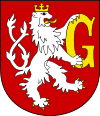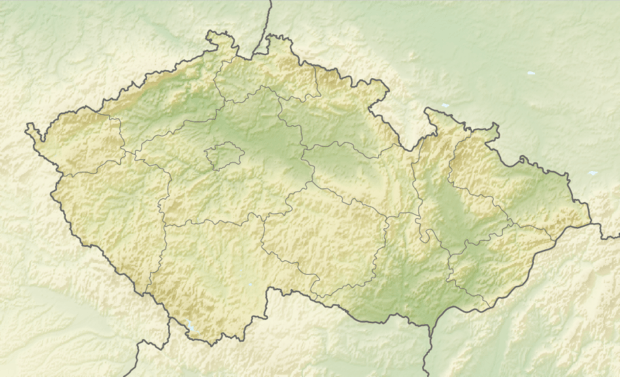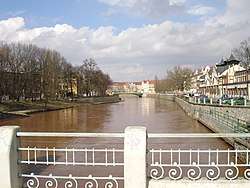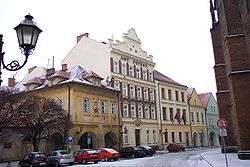Hradec Králové
Hradec Králové (Czech pronunciation: [ˈɦradɛts ˈkraːlovɛː] (![]()
Hradec Králové Königgrätz | |
|---|---|
_-_Velk%C3%A9_n%C3%A1m%C4%9Bst%C3%AD.jpg) Market square | |
 Flag  Coat of arms | |
| Nickname(s): The Salon of the Republic | |
 Hradec Králové Location in the Czech Republic | |
| Coordinates: 50°12′33″N 15°49′56″E | |
| Country | |
| Region | Hradec Králové |
| District | Hradec Králové |
| Founded | 1225 |
| Government | |
| • Mayor | Alexandr Hrabálek |
| Area | |
| • Total | 105.61 km2 (40.78 sq mi) |
| Elevation | 235 m (771 ft) |
| Population (2020-01-01[1]) | |
| • Total | 92,939 |
| • Density | 880/km2 (2,300/sq mi) |
| Time zone | UTC+1 (CET) |
| • Summer (DST) | UTC+2 (CEST) |
| Postal code | 500 00 |
| Website | www.hradeckralove.org |


_top_angle.jpg)
Geography
The city lies at the confluence of the Elbe and the Orlice rivers close to Krkonoše (Giant Mountains), the highest of the Czech mountains, with its peak, Sněžka (Snowhill), at 1,603 m.
History
The original name of one of the oldest settlements in the Czech Republic was Hradec (the Castle); Králové (of the queen) was affixed when it became one of the dowry towns of Elisabeth Richeza of Poland (1286–1335), who lived there for thirty years, having been the second wife of two Bohemian Kings, Wenceslaus II and then Rudolph I of Habsburg. In Latin, the Castle of the Queen was called Grecz Reginae, the original German Königingrätz was shortened to Königgrätz by 1800. It remained a dowry town until 1620.
Hradec Králové was the first town to declare for the national cause during the Hussite Wars in the first half of the 15th century. After the Battle of White Mountain (1620), a large segment of the Protestant population left the area. In 1639 the town was occupied for eight months by the Swedes. Several churches and convents were pulled down to make way for fortifications erected under Joseph II.
The Battle of Königgrätz, the decisive battle of the Austro-Prussian War, took place on 3 July 1866 near Hradec Králové. This event is commemorated in the famous "Königgrätzer Marsch". Moreover, the battle put an end to the age of fortifications, which were finally destroyed in 1884.
The city is situated in the centre of a very fertile region called the Golden Road, at the confluence of the Elbe and the Orlice, and contains many buildings of historical and architectural interest. The Cathedral of the Holy Spirit was founded in 1303 by Elizabeth, and the church of St. John, built in 1710, stands on the ruins of the old castle. During the 1920s and 1930s the city grew rapidly, thanks to decisions made by the heads of the city to develop a modern city, which included razing the fortress and opening the town for expansion. During this era many buildings of modern architecture were built, and Hradec Králové became known as the Salon of the Republic. This nickname was given to the city by its citizens, who were enamored by the architecture of Josef Gočár and Jan Kotěra.
Airport
Hradec Králové Airport is a public domestic and private international airport located about 3 km (1.9 mi) from the city centre.
There are currently no scheduled flights operating to the airport. It is sometimes visited by private jet traffic.
Culture
Theatre
Every May, an Air Ambulance Show is held for both the general public and Air Ambulance personnel. Every June the Theatre of European regions, an international theatre festival, takes place.
Music
Since 2004 the city hosts Hip Hop Kemp, one of the biggest European hip hop festivals, in August.
Since 2007 the city hosts Rock for People, the biggest rock festival in the Czech Republic, in July.
"Jazz goes to town", an international jazz festival, is held in Hradec Králové every October.
The city's museum currently holds one of the oldest surviving collections of Czech Renaissance polyphony, the Codex Speciálník manuscript.
The city is home to one of the Czech Republic's leading orchestras, the Hradec Králové Philharmonic Orchestra.
Sport
The ice hockey club of Hradec Králové is Mountfield HK, which plays in the Czech Extraliga.
The most successful football club is FC Hradec Králové, which plays in the Czech National Football League.
The women's basketball team, Hradecké Lvice, plays in the national women basketball league.
Notable people
- Jan Šindel (1370s–c.1456), scientist and professor
- Bohuslav Balbín (1621–1688), writer, historian and geographer
- Václav Kliment Klicpera (1792–1859), dramatist, writer and poet
- Carl von Rokitansky (1804–1878), physiologist, pathologist
- Antonín Petrof (1839–1915), piano maker
- František Plesnivý (1845–1918), architect
- Viktor Mucha (1877–1933), dermatologist
- Josef Gočár (1880–1945), architect
- Josef Čapek (1887–1945), painter, writer, poet
- Otakar Vávra (1911–2011), film director
- Avigdor Dagan (1912–2006), Israeli diplomat
- Jiří Horák (1924–2003), politician, first chairman of ČSSD
- Václav Snítil (1928–2015), violinist
- Jiří Petr (1931–2014), agroscientist, Rector Emeritus, Czech University of Agriculture Prague
- Dušan Salfický (born 1972), ice hockey player
- Sonja Vectomov (born 1979), Czech-Finnish electronic musician
- Vít Jedlička (born 1983), politician, publicist, president of Liberland
- Kateřina Siniaková (born 1996), tennis player
Twin towns – sister cities
Hradec Králové is twinned with:[4]










See also
References
- "Population of Municipalities – 1 January 2020". Czech Statistical Office. 30 April 2020.
- "Medical School". Archived from the original on 7 August 2004.
- "Pharmacy School". Archived from the original on 12 September 2007.
- "Partnerská města" (in Czech). Statutární město Hradec Králové. Retrieved 5 June 2020.
- "Spolupracující města" (in Czech). Statutární město Hradec Králové. Retrieved 5 June 2020.
External links
| Wikimedia Commons has media related to Hradec Králové. |
| Wikisource has several original texts related to: Hradec Králové |